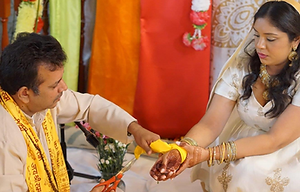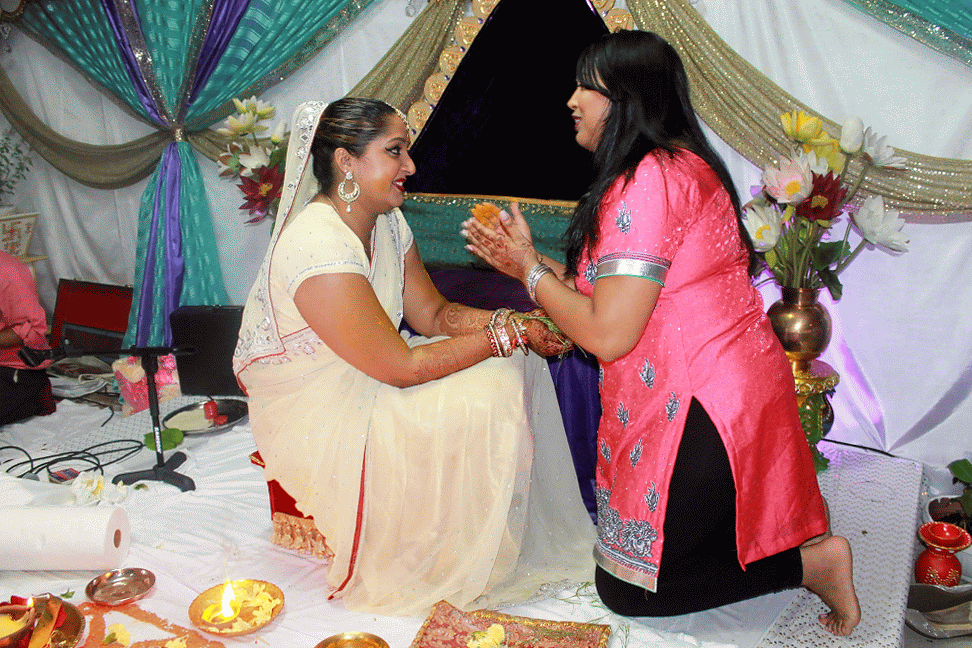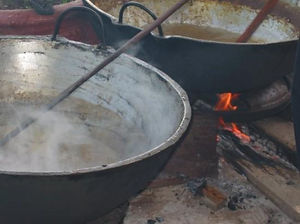Mehndi
A Mehendi ceremony is an Indian wedding ritual that typically happens one or two days before the wedding. In a typical Mehendi ceremony, all of the women in the bride and groom's families, along with close friends, gather together while the bride has elaborate henna designs applied to her hands and feet.

MAATI- KORE
'Maati' means Earth & 'Korna' means to dig or scoop
Maati-kore or more commonly spelled Maticoor, also known as dig-dutty in West Indian culture is the night before or two nights before the wedding. Many people call it the Haldi ceremony.
This is one of the first nights that follow rituals and offerings to the Hindu gods and goddesses. The mother of the bride and groom, along with other female family members, honor the earth and seek blessings for their child, the marriage of the couple, protection, and happiness.
Most commonly remembered as the night the bride and groom are covered in dye, a mixture of turmeric and oil, symbolic of purification and beautification for the wedding day.
In some West Indian cultures, after the Maticoor rituals, it becomes exclusively female-centered
focused on instructing the Dulahin (bride to be) on sexual matters through humor, dance song, and
role-play without censure. Throughout the centuries, this was a safe space for women to express themselves without the judgment of men, and also pass on traditions from mother to daughter.
memorable moments
Maticoor night is an important zone of female empowerment,
especially for the bride.
Maticoor night is an important zone of female empowerment,
especially for the bride.
need to know
Things get a little raunchy
beware: these aunties will teach you HOW TO BE married
To minimize events, some brides choose to have guest henna done on Maticoor night
DETAILS OF MATICOOR NIGHT
Where: Bride's House & Groom's House
When: the night before the wedding or two nights before the wedding
After the bride and groom are rubbed with dye, there are not to leave the yard for their protection until the morning of the wedding.
The bride and groom each have their own Maticoor night at their residence. This is predominately a female event. For the bride's side, it is strictly female empowerment. For the groom's side, it's not as spicy, however, that also depends on the family.
There are a few parts of the Maticoor Night
1. Maati-Kore (digging of the Earth)
2. Hardilaapan (rubbing of the dye)
3. Parch the Laawaa (parch grains until puffed)
Traditionally, Lawaa (popcorn kernals or grains) is to be parched and sifted the morning of the wedding day before the sun rises, however, to save time, many people patch the Lawaa at the end of Maati-kore night, which allows the ladies to express themselves freely for hours at the end of the night.

Blessing the Drums
At the start of the night, puja is done on the drums, to worship the divine sound. Sound is an internal part of the evolution of the human spirit. The mother of the bride/groom completes this puja by rubbing Sindoor, a red vermillion powder onto the drum. A gift is provided to the drummer, which is usually money.
Items Needed: Sindoor & Gift for the Drummer
The energetic and pulsing rhythms of the Tassa drums
starts off the mood of celebration.


Puja for Mother Earth, Dharti
A tray of puja items is prepared and carried on the head of one female. In some cultures, this person is the father's sister (bhauji) of the bride/groom and in other cultures, it is a young, unmarried girl.
Accompanied by the Tassa drummers, the ladies walk in the direction of where the bride or groom lives. Once finding a good spot, typically an area with rich soil, the ladies stop to perform the puja. At the end of the puja, the married ladies put Sindoor on their foreheads and dance to the beat of the Tassa drums back home.
In this ritual, dirt (Earth) from the puja site is taken back home.
Sometimes the drummers will block the entrance to the residence so the ladies can dance and put on a show to the Tassa.
Items Needed: 5 Paan Leaves, 5 Soparis, 5 Copper coins,
Flowers, Rice, a diya, oil, matches, Sindoor, and a hoe (for digging).
Upon returning home, the mother of the bride/groom
goes inside to bring their child to the Vedi.
Entrance to the Vedi
The Dulha (groom)/ Dulhin (bride) is escorted to the Vedi, which is the area prepared for the bride/groom puja. The mother uses one hand to drop water from a lota as they walk, and the other hand is used to cover her child with a scarf (orhni).
Items Needed: Lota of Water (for the mother)
The Mother usually wears yellow, representing a married woman.
The bride/groom wears white, representing purity.

Planting the Bamboo
After the dulha/dulhin sits on the Vedi, the pundit performs a purification process around the area. Prayers are recited, mantras are read for celestial peace, and the bamboo is planted by five men, along with a harris and banana plant (Sukka Plant).
Items Needed: 1 bamboo, 5 Mango Leaves, coins, rice, flowers, and 1 supari.

Puja for Ganesh, Phritvi, Kalsha, and Laksmi
Puja is performed by the bride/groom to Ganesh (remover of obstacles), Phritvi Maa (Mother Earth), Kalash Deva (representation of the earth, nature, and nourishes of life. Havan is done in the completion of this part.
Items Needed: Puja supplies

Kankan Bandhan
Kankan Bandhan is a protective string that is tied around the wrist of the bride/groom to ward off evil. On the string, there are a few items that are attached such as grains of rice and a small knife. Protection of the bride/groom.
Items Needed: Kankan Bandhan


Haridralaapan - Rubbing Dye
'Haridra' means Tumeric. 'Laanpan' means to rub. It is customary for five young girls (young, pure, and unmarried) to participate in this part.
Each girl touches the bundle of doob grass in the dye, touches the feet, knees, shoulders, and circles around the head of the bride/groom. All while the bride/groom holds a handful of grains.
After this is completed, the mother of the bride/groom follows closely the bride/groom back inside, while throwing water from the lota. The grains and dye are also brought inside, for the additional dye rubbing sessions totaling to five or seven times.
These are the steps to purifying the body and mind in preparation of the wedding day.
Fun Fact: The properties of the dye, lightens, and brighten the skin tone of the bride and groom.
Items Needed: Tumeric, Oil, Rice, Dhoob Grass

Parch the Laawa
Laawa is parched rice or popcorn that is used during the wedding ceremony. During this, the ladies are talking, telling stories, and singing.
In some cultures, this is where the ladies share their stories or role-play to sexual activities to teach the bride. This is where the night gets spicy, seeing a side of your elders you've haven't seen before.
Items needed: Kernels of popcorn or rice grains
fun fact
"Maticoor night is for ladies to get away
they don't really care what anyone says"
is the lyrics to a common song,
that describes the evening all too well
what to waer
Brides wear a white saree or simple lengha
Mother of the bride/groom wears yellow Indian-wear
Guest(s) wears simple Indian wear, long informal dresses or long skirts.
You can't have aMaticoor night without Tassa... Check Out our Vendors










